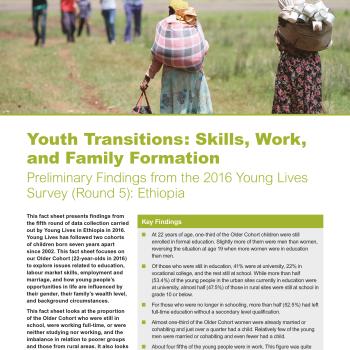Publication Information

Round 5 Longitudinal Youth Transitions: Skills Work and Family Formation Fact Sheet
This fact sheet presents findings from the fifth round of data collection carried out by Young Lives in Ethiopia in 2016. Young Lives has followed two cohorts of children born seven years apart since 2002. This fact sheet focuses on our Older Cohort (22-year-olds in 2016) to explore issues related to education, labour market skills, employment and marriage, and how young people’s opportunities in life are influenced by their gender, their family’s wealth level, and background circumstances. This fact sheet looks at the proportion of the Older Cohort who were still in school, were working full-time, or were neither studying nor working, and the imbalance in relation to poorer groups and those from rural areas. It also looks at the proportion of the young people in our sample who were married or already had a child of their own. Finally, it identifies differences between urban and rural areas in the use of digital devices.
Key Findings:
At 22 years of age, one-third of the Older Cohort children were still enrolled in formal education. Slightly more of them were men than women, reversing the situation at age 19 when more women were in education than men. Of those who were still in education, 41% were at university, 22% in vocational college, and the rest still at school. While more than half (53.4%) of the young people in the urban sites currently in education were at university, almost half (47.5%) of those in rural sites were still at school in grade 10 or below. For those who were no longer in schooling, more than half (52.5%) had left full-time education without a secondary level qualification. Almost one-third of the Older Cohort women were already married or cohabiting and just over a quarter had a child. Relatively few of the young men were married or cohabiting and even fewer had a child. About four fifths of the young people were in work. This figure was quite high across all groups, irrespective of gender. The poorest young people were the most likely to be in work. While 58% of the employed young people from rural sites were working in agriculture, 91% of those employed from the urban sites were working in other sectors. Usage of digital devices among 22-year-olds is low, and there is a huge difference between urban and rural areas in their use.

Round 5 Longitudinal Youth Transitions: Skills Work and Family Formation Fact Sheet
This fact sheet presents findings from the fifth round of data collection carried out by Young Lives in Ethiopia in 2016. Young Lives has followed two cohorts of children born seven years apart since 2002. This fact sheet focuses on our Older Cohort (22-year-olds in 2016) to explore issues related to education, labour market skills, employment and marriage, and how young people’s opportunities in life are influenced by their gender, their family’s wealth level, and background circumstances. This fact sheet looks at the proportion of the Older Cohort who were still in school, were working full-time, or were neither studying nor working, and the imbalance in relation to poorer groups and those from rural areas. It also looks at the proportion of the young people in our sample who were married or already had a child of their own. Finally, it identifies differences between urban and rural areas in the use of digital devices.
Key Findings:
At 22 years of age, one-third of the Older Cohort children were still enrolled in formal education. Slightly more of them were men than women, reversing the situation at age 19 when more women were in education than men. Of those who were still in education, 41% were at university, 22% in vocational college, and the rest still at school. While more than half (53.4%) of the young people in the urban sites currently in education were at university, almost half (47.5%) of those in rural sites were still at school in grade 10 or below. For those who were no longer in schooling, more than half (52.5%) had left full-time education without a secondary level qualification. Almost one-third of the Older Cohort women were already married or cohabiting and just over a quarter had a child. Relatively few of the young men were married or cohabiting and even fewer had a child. About four fifths of the young people were in work. This figure was quite high across all groups, irrespective of gender. The poorest young people were the most likely to be in work. While 58% of the employed young people from rural sites were working in agriculture, 91% of those employed from the urban sites were working in other sectors. Usage of digital devices among 22-year-olds is low, and there is a huge difference between urban and rural areas in their use.

